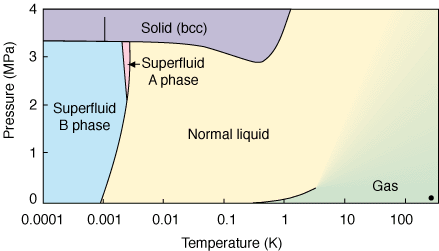Helium
Helium is the second lightest element after hydrogen.
It is known as a light gas that is used to float balloons.
It becomes liquid when it is cooled to a very low temperature.
Helium is the only
substance that remains liquid at absolute zero of temperature,
0 K (zero Kelvin), or -273.15 Celsius.
All other substances solidify at temperatures higher than 10 K,
see a typical phase diagram.
Helium has two stable isotopes 4He and 3He.
Usually different isotopes of the same substance differ only in their mass.
However, the helium isotopes behave very differently when they are cooled to
temperatures below a few Kelvin.
A mixture of the two isotopes
separates spontaneously at temperatures below 0.8 K.
The liquids of both isotopes become
superfluids at low temperatures, 4He below 2.17 K, and
3He below 0.0025 K.
 4He is the more common isotope of helium.
The figure shows the phase diagram of 4He at low temperatures.
4He remains liquid at zero temperature if the pressure is
below 2.5 MPa (approximately 25 atmospheres).
The liquid has a phase transition to a
superfluid phase, also known as He-II, at the temperature
of 2.17 K (at vapor pressure).
The solid phase has either hexagonal close packed (hcp)
or body centered cubic (bcc) symmetry.
4He is the more common isotope of helium.
The figure shows the phase diagram of 4He at low temperatures.
4He remains liquid at zero temperature if the pressure is
below 2.5 MPa (approximately 25 atmospheres).
The liquid has a phase transition to a
superfluid phase, also known as He-II, at the temperature
of 2.17 K (at vapor pressure).
The solid phase has either hexagonal close packed (hcp)
or body centered cubic (bcc) symmetry.
 The phase diagram of 3He is shown in the figure.
Note the logarithmic temperature scale.
The dot in the lower right hand corner denotes room temperature
and pressure.
There are two
superfluid phases of 3He, A and B.
The line within the solid phase indicates
a transition between spin-ordered and spin disordered structures
(at low and high temperatures, respectively).
The phase diagram of 3He is shown in the figure.
Note the logarithmic temperature scale.
The dot in the lower right hand corner denotes room temperature
and pressure.
There are two
superfluid phases of 3He, A and B.
The line within the solid phase indicates
a transition between spin-ordered and spin disordered structures
(at low and high temperatures, respectively).
The reason for the different behavior of 4He and 3He
is quantum mechanics. 4He is a boson. The appearance of the
superfluid phase in 4He is related to Bose condensation, where a
macroscopic fraction of the atoms is in the lowest-energy one-particle
state. 3He is a fermion (like electron) and it is forbidden by
the Pauli exclusion principle that more than one fermion is in the same
one-particle state. The superfluidity arises from formation of weakly
bound pairs of fermions, so called Cooper pairs. The pairs behave as bosons.
In the superfluid state there is a macroscopic occupation of a single Cooper
pair state.
Researh on helium in LTL/Helsinki University of Technology
19.8.2003, Erkki Thuneberg, Email,
Suomeksi
 4He is the more common isotope of helium.
The figure shows the phase diagram of 4He at low temperatures.
4He remains liquid at zero temperature if the pressure is
below 2.5 MPa (approximately 25 atmospheres).
The liquid has a phase transition to a
superfluid phase, also known as He-II, at the temperature
of 2.17 K (at vapor pressure).
The solid phase has either hexagonal close packed (hcp)
or body centered cubic (bcc) symmetry.
4He is the more common isotope of helium.
The figure shows the phase diagram of 4He at low temperatures.
4He remains liquid at zero temperature if the pressure is
below 2.5 MPa (approximately 25 atmospheres).
The liquid has a phase transition to a
superfluid phase, also known as He-II, at the temperature
of 2.17 K (at vapor pressure).
The solid phase has either hexagonal close packed (hcp)
or body centered cubic (bcc) symmetry.
 The phase diagram of 3He is shown in the figure.
Note the logarithmic temperature scale.
The dot in the lower right hand corner denotes room temperature
and pressure.
There are two
The phase diagram of 3He is shown in the figure.
Note the logarithmic temperature scale.
The dot in the lower right hand corner denotes room temperature
and pressure.
There are two